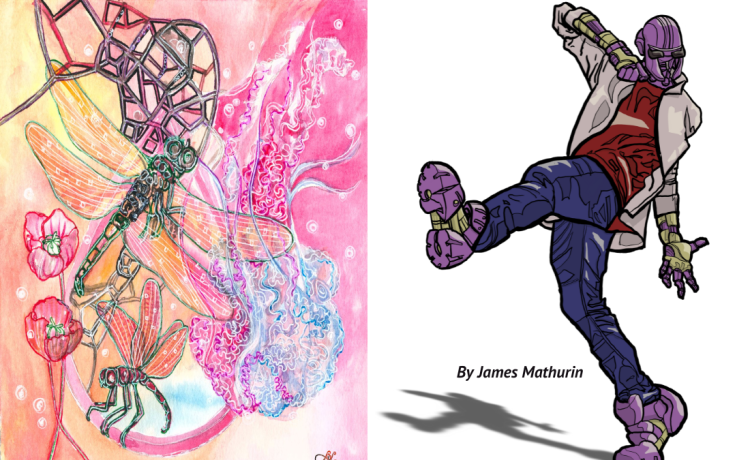Left: Welcome Change by Anthony Van Lam Right: Robo Dancer by James Mathurin
In the vast canvas of artistic expression, the age-old debate between traditional and digital art continues to captivate the hearts and minds of creators. Each medium carries its distinct charm, offering a spectrum of advantages and disadvantages that artists must consider when venturing into the world of artistic creation. This exploration aims to guide artists in appreciating both realms, enabling them to make informed decisions based on their artistic projects and desired outcomes.
Traditional Art: Embracing the Tangible Craft
Advantages:
- Tactile Experience: Traditional art, encompassing mediums like painting, drawing, and sculpture, provides artists with a tangible and tactile experience. The feel of the brush on canvas, the texture of paper, and the physicality of sculpting contribute to a sensory richness that resonates with many creators.
- Unique Textures: Traditional mediums allow for the creation of unique textures and surfaces. Whether through brushstrokes, palette knife techniques, or varied paper types, traditional artists can manipulate materials to add depth and character to their creations.
- Physical Presence: Traditional artworks have a physical presence that occupies space. This presence enhances the connection between the artwork and its audience, fostering an immersive experience that digital art may sometimes struggle to replicate.
Disadvantages:
- Limited Undo: Traditional artists lack the luxury of a digital “undo” button. Mistakes or changes in direction may necessitate starting over or adapting to unforeseen alterations.
- Time-consuming: The process of creating traditional art can be time-consuming. Drying times for paint, meticulous detailing, and the intricate nature of certain techniques contribute to extended project timelines.
- Limited Reproducibility: Replicating traditional art for mass production or distribution may pose challenges. Each piece carries a unique quality that is challenging to reproduce consistently.
Digital Art: Navigating the Digital Canvas
Advantages:
- Efficiency and Editability: Digital art provides unparalleled efficiency with its undo and edit features. Artists can experiment freely, backtrack, and refine their work without the constraints associated with traditional mediums.
- Versatility: The digital canvas offers a vast array of tools and effects, providing artists with limitless possibilities for exploration and experimentation. The ability to mimic traditional mediums or delve into entirely new styles expands the boundaries of creative expression.
- Collaboration and Sharing: Digital art simplifies collaboration and sharing. Artists can easily collaborate on projects in real time, share their work globally, and engage with a diverse online community.
Disadvantages:
- Lack of Tangibility: The absence of a tangible, physical form can be a drawback for some creators. The inability to physically touch or experience the texture of the artwork may create a disconnect for those accustomed to traditional mediums.
- Learning Curve: Transitioning to digital art requires a learning curve. Mastering software, understanding digital tools, and adapting to the nuances of a digital canvas can be challenging for artists accustomed to traditional techniques.
- Dependency on Technology: Digital artists are reliant on technology. Technical malfunctions, software updates, or hardware issues can disrupt the creative process, underscoring the need for regular maintenance and technological proficiency.
Balancing Tradition and Innovation: Making Informed Choices
As artists stand at the crossroads of tradition and innovation, the key lies in recognizing the merits of both realms and making informed choices based on the project at hand. Traditional art offers a sensory and timeless experience, while digital art provides efficiency, versatility, and global connectivity.
In the pursuit of artistic expression, creators need not choose one path over the other. The intersection of traditional and digital art allows for a harmonious blend, where artists can leverage the strengths of each medium to amplify their creative impact. By appreciating the advantages and disadvantages of both traditional and digital art, artists can navigate the diverse palette of creativity, making choices that align with their artistic vision and resonate with their desired outcomes. Whether painting with a brush on canvas or sculpting with pixels on a digital canvas, artists find themselves in a rich tapestry of creative possibilities, where the fusion of tradition and innovation opens doors to endless artistic horizons.
Want to learn more?
- Find out more
- Launch Pad + Accelerator Expressions of Interest
- Selling and Licensing Your Art & Designs Around the World with ArtSHINE.
We’re here to help you to take action, just like we’ve helped thousands of other entrepreneurs, business owners, and creative professionals all around the globe.
Now is the time to let your passion SHINE.
Now is the time to Make Tomorrow Today!
To your success, Vinh Van Lam and Stuart Horrex Cofounders
ArtSHINE.com





